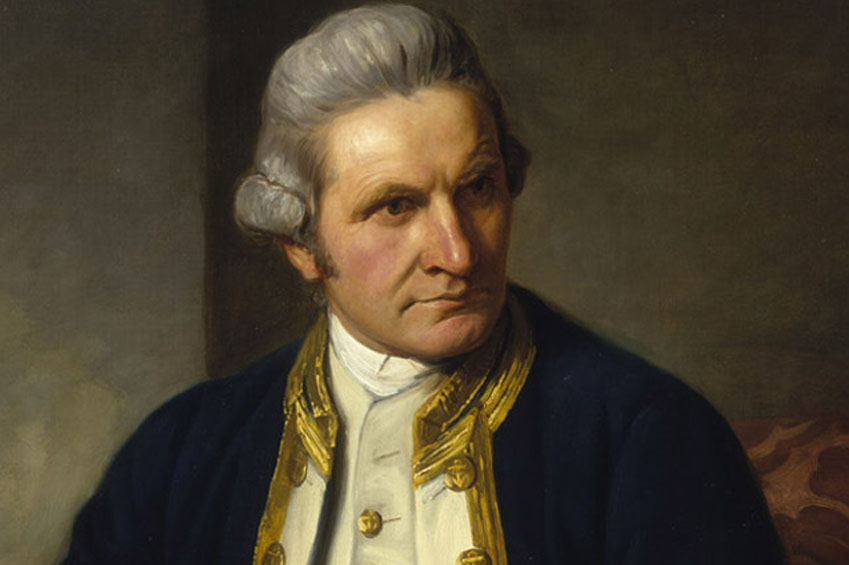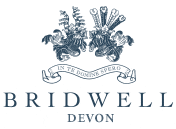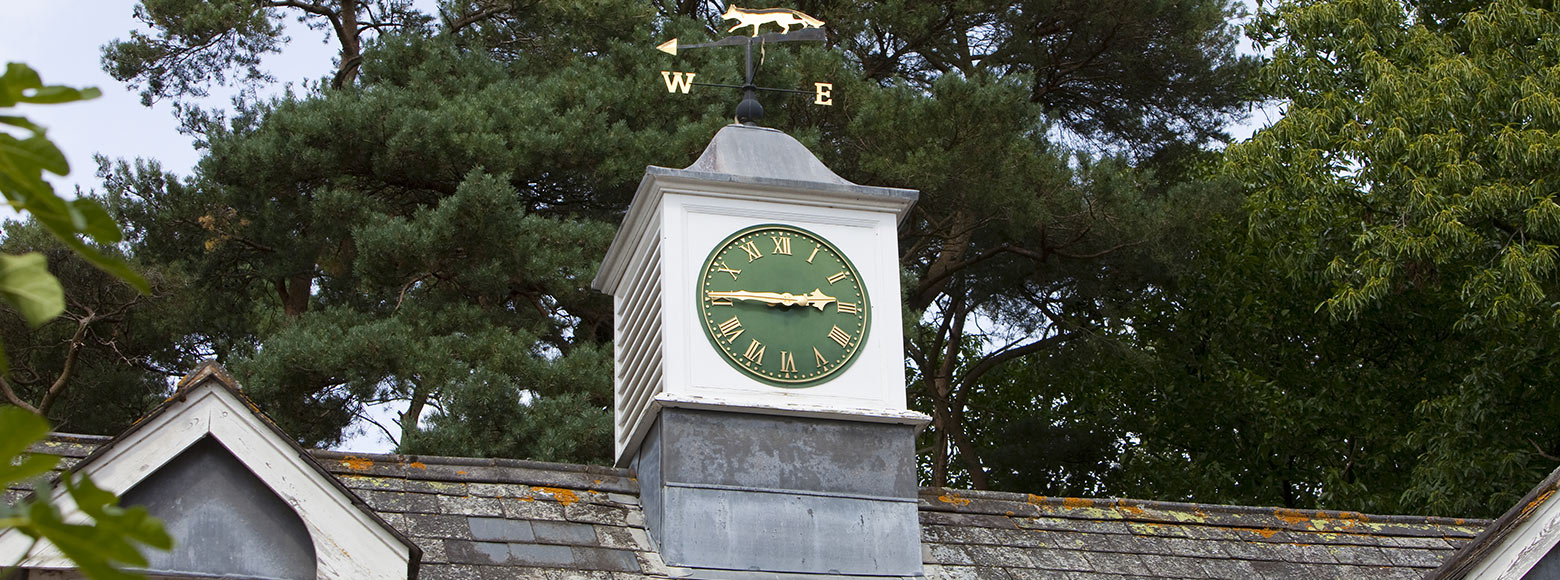Captain James Cook is recognised as one of the greatest British explorers in history. The 18th century Royal Navy captain is credited with successfully completing three voyages to the Pacific Ocean and discovering Australia and the Hawaiian islands.
Born in Marton-in-Cleveland in 1728, he worked on his father’s farm in his youth, before moving to the fishing village of Staithes at 16, to work as a shop boy. It is believed he first felt the lure of the sea while working there, after deciding he wasn’t suited to shop work.

Credit: Wikipedia
He became a merchant navy apprentice instead, studying geometry, algebra, trigonometry, astronomy and navigation — the skills he would one day need to command his own ship. After completing a three-year apprenticeship and passing his examinations in 1752, he worked his way up through the merchant navy ranks, until in 1755, when he volunteered for the Royal Navy.
First voyage
His first posting was as an able seaman and master’s mate on HMS Eagle. He served during the Seven Years’ War and proved his skills in cartography and surveying. This led to his appointment to the HMS Grenville to survey the coast of Newfoundland in the 1760s.
Between 1763 and 1767, he sailed along the north-west coast, the south coast and finally the west coast. His voyage produced the first accurate, large-scale maps of Newfoundland, using precise triangulation to establish the outline of the land.
In May 1768, the Admiralty commissioned him to undertake a voyage of discovery to the Pacific Ocean. Aged 39, he was promoted to lieutenant for his pioneering expedition on his now famous ship, HMS Endeavour.
He left England on 26th August 1768, sailed around Cape Horn and travelled across the Pacific to Tahiti, arriving on 13th April 1769.
Terra Australis
He was tasked with searching the South Pacific for signs of Terra Australis, a hypothetical continent. Scientists speculated that the land in the northern hemisphere would be balanced by land in the southern hemisphere and Cook’s job was to prove their theory, which had no scientific basis.
He mapped the whole coastline of New Zealand and then continued west, arriving at the south-east coast of Australia on 19th April 1770. It was the first recorded visit by Europeans.
After first observing indigenous Australian people at Brush Island on 23rd April, he kept a detailed journal and as the Endeavour sailed close to the shore, he was able to “distinguish several people upon the sea beach”.
Cook and his crew made their first landing on 29th April on the mainland at the Kurnell Peninsula. He christened the area “Botany Bay”, after the ship’s botanists, Daniel Solander and Joseph Banks, found many unique specimens. Cook also made contact with an Aboriginal tribe, the Gweagal.
Continuing north, he went ashore at Bustard Bay on 24th May, but the Endeavour ran aground at the Great Barrier Reef on 11th June, delaying the mission for seven weeks while repairs were completed. The Endeavour finally reached the northern tip of the coast, which Cook named Cape York, on 22nd August 1770.
He wrote that he had claimed possession of the entire coastline. He navigated the Endeavour back to England via Batavia (now known as Jakarta, Indonesia) and the Cape of Good Hope, arriving at Saint Helena Island on 12th July 1771.
On his return to England, Cook had his journals published and became a hero among the general public and the scientific community.
Antarctic Circle
Again, looking for the hypothetical Terra Australis, he embarked on a second voyage from 1772 to 1775, this time on HMS Resolution. It was believed to lie further south than the lands he had discovered on his first journey. A second ship, HMS Adventure, commanded by Tobias Furneaux, set off with HMS Revolution.
This was the first expedition to cross the Antarctic Circle on 17th January 1773, but after becoming separated in the fog, Furneaux sailed on to New Zealand alone, encountered hostile Māori people and decided to return to England.
Cook continued exploring the Antarctic and then went on to Tahiti, as he needed supplies for his ship. Still unable to find the supposed Terra Australis, he returned to New Zealand in 1774. This time, he landed at Easter Island, the Friendly Islands, Norfolk Island, New Caledonia and Vanuatu.
Returning to England via South Africa in 1775, he reported definitively that Terra Australis was just a myth and couldn’t possibly exist.
Final journey
Cook’s third voyage set off in 1776, again on the HMS Resolution, accompanied by the HMS Discovery, captained by Charles Clerke. The expedition’s new goal was to find the north-west passage around America. They sailed down the west coast of America and landed on the Oregon coast, but bad weather forced the ships to re-route.
They docked at Resolution Cove and traded for supplies with the local Yuquot people. Cook reported that the locals wanted lead, pewter and tin items, rather than the “trinkets” the English had traded on earlier expeditions. He noted a “strained” relationship on occasion.
In August 1778, Cook sailed through the Bering Strait and headed up the coast of Alaska, but his route was blocked by ice, so he began the trip back via the Hawaiian Islands. They arrived during the Makahiki – a festival to worship the god, Lono.
They remained there for a month, but as they attempted to leave, the Resolution’s mast broke and they had to stay longer for repairs. It was reported that tensions increased with the local people, who stole a small boat from the English and remained defiant, even when Cook and the crew threatened to fire at them.
Unfortunately, the situation quickly deteriorated into conflict with some of the villagers. In the ensuing skirmishes, Cook and several of his crew lost their lives on 14th February 1779. They were given a formal burial at sea and the expedition returned home to England in mourning.
Cook’s friend and colleague, Royal Navy officer James King, completed the late captain’s journals to provide a full account of the expedition. Tributes were paid to Cook, who was described by David Samwell (a crew member on Resolution) as a “modest, sensible and intelligent man”, with a “friendly, humane and benevolent” disposition.
Cook left a massive legacy for future generations, thanks to his bravery in exploring the world at a time when he was literally sailing into the unknown, without the aid of any modern technology.
Coin find
In 2018, a surprise find of a Tanzanian copper coin, dating back nearly 1,000 years, on the Wessel Islands, off the coast of Australia, added a new mystery to the tales of Cook’s voyages of discovery. Scientists are probing how it might have got there and one suggestion is that Portuguese sailors may have reached Australia 250 years before Cook.
The Portuguese had raided Kilwa, in the Lindi region of Tanzania, in 1505, so scientists believe they may have left the coin on the Wessel Islands during their travels. This would mean they had potentially reached the Australian mainland. However, it is also reported that many items wash up on the Australian shore all the time.
Bridwell Park
Many of the historic artefacts that Cook brought back to England from his travels were at one time on display at Bridwell Park in the purpose-built, Gothic-style chapel.
Bridwell Park is a Grade I listed estate in Uffculme, Devon. The fascinating country house and 100-acre estate opened up its rich heritage to the public in 2015, for the first time in its 240-year existence. The property (which has a Downton Abbey feel) has been home to Lord Ivar Mountbatten and his family since 1997.
Built in Regency style by Richard Hall between 1774 and 1779, the Gothic-style chapel was used solely as a museum, with the aim of exhibiting Cook’s amazing artefacts from around the world.
The ten-bedroom house (with an additional 8 bedrooms in the old stable block), with its own orangery and tennis court, is more used to welcoming guests than explorers today. The museum, now called “The Chapel”, provides the perfect backdrop for a wide audience of people and varied events, including everything from weddings and murder mystery evenings, to yoga classes.
Organisers of corporate events, private parties and other celebrations can hire the chapel, main house, orangery or a marquee in the park’s grounds for an event to remember – I honestly can’t think of anywhere more beautiful!
Please contact us for assistance.
Click the following link for further information on Captain Cook at Bridwell Park.


